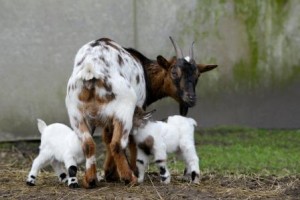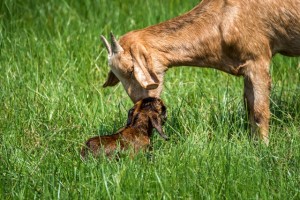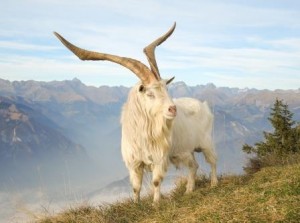Breeding Season
The annual reproductive cycle in goat breeds from temperate latitudes and in some local breeds from the subtropics is controlled by day length, and reproduction is seasonal with females ovulating during short days but not during long days (Gebbie et al., 1999; Lebouef et al., 2008; Delgadillo, 2011).
In seasonal breeders, sexual behaviour, testicular size and sperm quality and quantity decreases dramatically during the non-breeding season (Delgadillo et al., 1999). In the high latitude regions, goats are anoestrus during the periods when day lengths are long. As the daily periods of darkness lengthen, the breeding period starts and both oestrus behaviour and cyclic ovarian activity occur. During the transition between these two distinct periods, goats can undergo anovulatory oestrus or silent ovulations (ovulations are not accompanied by oestrous behavior) (Fatet et al., 2011). Exposure to males can be used to extend the breeding period both before and after the natural breeding period.
Most breeds of tropical and sub-tropical origin breed all-year-round (Amoah et al., 1996). In the tropics, where there are not seasonally pronounced differences in day length, breeding and anoestrus periods are more likely to be influenced by the availability of nutrition (see later section).
For more on Goat Breeds
Puberty and the onset of breeding
Puberty in females is the age that oestrus is first detected, followed by cyclic ovarian activity. In the male it is the initiation of spermatogenesis. Goats reach puberty at approximately five months of age with the actual age being determined by a number of factors, but especially nutrition and liveweight in relation to mature bodyweight. Age at puberty can also be influenced by season of birth and season of weaning. The presence or absence of a male is also a significant factor.
Generally breeding in goats should be delayed until the animal has attained 60–75% of its mature bodyweight (Greyling, 2000).
 Litter size
Litter size
There can be significant breed differences in litter size, with lighter breeds e.g. Pygmy breed tending to have larger litters (Amoah et al., 1996). The ovulation rate, or the number of ova released during ovulation influences the number of kids born per doe kidding.
The oestrus cycle
Does are seasonally polyoestrus with an oestrous cycle that lasts approximately 21 days. Reproduction efficiency in female goats is determined by processes such as the length of the breeding season, cyclic activity, ovulation rate, fertilisation rate, the post-partum anoestrous period and the growth and viability of the offspring. As such, measures of reproductive efficiency may include the kidding rate, weaning rate, kidding interval, liveweight of kids born or weaned and the length of the reproductive cycle (Greyling, 2000).
Oestrous behavior
Oestrus behaviour normally lasts for about 36 hours, but depending on age, individuals and breeds, season and the presence of a male, can vary from 24 to 48 hour or longer. Angora and Mossi goats in particular have short oestrus of only 22 h and 20 h, respectively and the Matou goats from China have been reported as having oestrus periods of more than 2 days. Similarly, the time from the start of oestrus and the time when ovulation takes place can also vary considerably (from 9 hours to 37 hours) and is again dependent on the breed (Fatet et al., 2011). The continuous presence of a male can reduce oestrus length (Romano and Abella, 1997).
Mating occurs during oestrus, and therefore the male sperm may be present in the female genital tract before ovulation occurs. The sperm can be preserved in the cervix for up to 3 days and continuously released in the uterus. The sperm cannot survive in the uterus for more than about 30 hours (Fatet et al., 2011).
Signs of a doe in heat
- Reduced appetite and milk yield
- Seeking out the buck
- Restlessness
- Frequent urination
- Vocalization/bleating
- Mounting or allowing mounting by other does
- Swelling, redness, and/or presence of mucus on the vulva
- Tail wagging
- Vaginal discharge
The Buck Effect
The so-called male or buck effect is a technique to stimulate the sexual activity in seasonally anovulatory goats. Most female goats have a short ovarian cycle of 5–7 days after a buck is introduced which is then followed by a second ovulation which is associated with oestrous (Chemineau et al., 2006; Fatet et al., 2011).
See Goat Behaviour for more on other behaviours.
Pregnancy
Goats are normally pregnant for 149 days and there can be some very small variation depending on various factors such as season and breed.
Nutritional influences
Levels of reproductive performance are dependent on genetic and environmental interactions, with the seasonal availability of nutrition perhaps having the greatest influence. Although some goat breeds have an excellent ability to adapt to nutritional extremes, this can negatively impact on reproduction (Greyling, 2000) and the seasonal availability of nutrients can affect reproduction considerably (Riera, 1982). For more on Goat Nutrition


 American English
American English



Comments are closed.